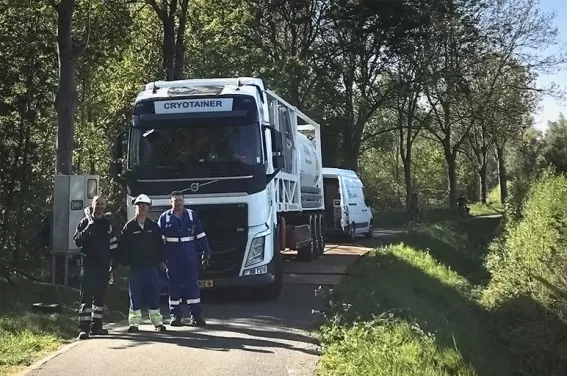
Environmental disaster narrowly averted in the Flemish Scheldt

Cryotainer’s Mobile Oxygen Vessel injects pure oxygen
The story begins on 9 April 2020. That night, a breach in a collection basin at a food processing plant near the town of Cambrai in France released close to 100,000 m³ of wastewater into the Scheldt river. The wastewater contained huge quantities of bacteria which consumed almost all the oxygen in the water, causing fish to die on a massive scale. In the days that followed, the pollution gradually spread further downstream, heading towards Belgium...
Wallonia and Flanders
By 20 April, the first dead fish were being spotted in Antoing in Wallonia, near the French border. Just three days later, the Walloon Region was estimating that 50 to 70 tonnes of fish had died along the approximately 36-km Walloon section of the Scheldt. Fortunately, the Walloon Region communicated in good time about the pollution, which was now making its way to Flanders.
On receiving word of the pollution, the Flemish Environment Agency installed oxygen meters at multiple points along the Scheldt. “They continuously measure the amount of oxygen in the water,” explains Zuhal Demir, Flemish Minister of Justice and Enforcement, Environment, Energy and Tourism. “We can monitor the data online in real time. The water authorities can then use the information to determine appropriate measures.”
That is precisely what happened soon after. De Vlaamse Waterweg (Flemish Waterways) decided to add large quantities of oxygen to the water to try to save the fish and, on 22 April, they contacted Air Liquide to ask if they could mobilise the necessary staff and equipment very quickly to avoid the impending disaster.
Race against time
“From then on, things moved very fast,” says Rudy Lamond, Growth & Innovation Leader for Water Treatment at Air Liquide. “We got to work right away to see if we could get the required people and supplies in place in time. It was a race against time because the pollution was rapidly closing in.”
Within 24 hours, Air Liquide was able to assure De Vlaamse Waterweg that they could supply the equipment needed to pump large amounts of oxygen into the Scheldt quickly and in good time, as requested.
Lamond: “Our proposal was universally approved at De Vlaamse Waterweg and, less than 24 hours later, the installation was operational. A good thing too — the pollution showed up barely two hours later.”
1,500 holes
The turning basin at Semmerzake was determined to be the best location to inject oxygen into the waters of the Scheldt. Air Liquide and Cryotainer (an Air Liquide subsidiary) set up a Mobile Oxygen Vessel (a trailer with a liquid oxygen tank and a vaporiser to convert liquid oxygen into gas), a dosing and control unit and six porous oxy-injection frames, known as Poroxals (Porous Oxy-injection frames).
“Each frame supports an air hose that has 1,500 holes per linear metre. The holes release tiny air bubbles, creating a greater contact surface than larger bubbles. And because smaller bubbles are slower to rise to the surface, they can transfer more oxygen to the water. Apart from that, the Poroxals also have much greater impact because we use pure oxygen,” Lamond explains.
Pure oxygen is 99.5 % oxygen, while pumped air contains only 21 % oxygen. The installation injected close to 150 kg of pure oxygen per hour into the waters of the Scheldt. This resulted in an oxygen-rich zone in the turning basin, with an oxygenated plume drifting downstream.
“Because of this rapid intervention — and the joint efforts of the various government agencies and industrial companies — we saved 95% of the fish population in the Scheldt in Flanders and, by so doing, we were able to prevent the imminent collapse of the river’s biodiversity.”
Future plans
De Vlaamse Waterweg is now firmly convinced of the effectiveness of this type of installation. The organisation has consequently now invested in an 800-metre porous air hose that can be connected to a Mobile Oxygen Vessel.
“There is no doubt whatsoever that having installations like this available — either fixed or mobile — is very worthwhile as a precaution against future mishaps. And not just for catastrophes like this,” Lamond continues.
“The system can also be useful in controlling the excessive growth of blue-green algae in ponds, for example. Global warming has led to more frequent periods of sustained drought, often ending in heavy storms. Such massive rainfall washes a lot of nutrients into the water, causing the blue-green algae to increase dramatically. The algae produce toxins, and these toxins are a threat to the quality of the drinking water.”
“Air Liquide recently set up an installation with Poroxal oxygen injectors in the Seine river. When the surrounding area is hit by too much rain, too quickly, the local wastewater treatment plants can no longer keep up with the large quantities of water. That means that wastewater from the drains — there are no separate rainwater and wastewater systems in the region as yet — ends up in the Seine. This has already killed huge numbers of fish several times in the past. The new installation will mean similar events can be prevented in future.”